By: Team AY1920S2-CS2103-T09-4 Since: Feb 2020 Licence: MIT
- 1. Introduction
- 2. Quick Start
- 3. Common Fields and Keywords
- 4. Features
- 4.1. Viewing help :
help - 4.2. Keep Food and Sports Entries
- 4.2.1. Go to dashboard page:
home - 4.2.2. Adding an entry:
add - 4.2.3. Listing all entries :
list - 4.2.4. View Reminder :
reminder - 4.2.5. Editing an entry :
edit - 4.2.6. Locating entries by name:
find - 4.2.7. Deleting an entry :
delete - 4.2.8. Sort food/sports entry list:
sort - 4.2.9. Check calorie intake/consumption of common food/sports:
check
- 4.2.1. Go to dashboard page:
- 4.3. Keep Diaries
- 4.4. Clear All Entries And Diaries:
clear - 4.5. Undo :
undo - 4.6. Redo :
redo - 4.7. Calendar View
- 4.8. Daily Summary
- 4.9. Weekly Summary
- 4.10. Keep User Profile
- 4.11. Keep Weight Records
- 4.12. Exit the program :
exit/bye/quit - 4.13. Save the data
- 4.1. Viewing help :
- 5. Command Summary
1. Introduction
FitHelper (FH) is for those who prefer to use a desktop app for managing daily diet and exercises. More importantly, FH is optimized for those who prefer to work with a Command Line Interface (CLI) while still having the benefits of a Graphical User Interface (GUI). If you can type fast, FH can get your weight management tasks done faster than traditional GUI apps. Interested? Jump to the Section 2, “Quick Start” to get started. Enjoy!
FitHelper mainly serves as a fitness log book where users can mark down their diet and exercises entries and be reminded about their plans. They can also visualize their performance to be encouraged.
2. Quick Start
-
Ensure you have Java
11or above installed in your Computer. -
Download the latest
FitHelper.jarhere. -
Copy the file to the folder you want to use as the home folder for your Fitness Helper. Please ensure that writing or reading data inside the home folder that you choose does not require administrator permission.
-
Double-click the file to start the app. The GUI should appear in a few seconds. (For Mac, the window size can be enlarged but the zoomed out window version is not functioning currently. So, window size should be kept. For Windows, the window size cannot be changed.)
 Figure 1. A snapshot of the app
Figure 1. A snapshot of the app -
Type the command in the command box and press Enter to execute it.
e.g. typinghelpand pressing Enter will open the help window. -
Some example commands you can try:
-
list: lists all logs -
addx/s n/swimming t/Wednesday 18:00 l/utown gym c/500: adds an entry namedswimmingto the dashboard page. -
deletei/3 x/f: deletes the 3rd entry from food entry list shown in the dashboard -
exit: exits the app
-
-
Refer to Section 4, “Features” for details of each command.
3. Common Fields and Keywords
-
x/ entry type
-
n/ entry name
-
t/ entry time
-
l/ entry location
-
c/ entry calorie
-
s/ entry status
-
r/ entry remark
-
i/ entry index
-
d/ date in format yyyy-MM-dd
-
m/ mode
-
sh/ date in format of yyyy-MM-dd in calendar
-
dc/ diary content
-
dr/ duration
-
attr/ profile attribute name
-
v/ profile attribute value/ weight value
-
by/ sorting criterion
-
o/ sorting order
-
k/ keywords for searching/checking
-
-f force change flag
4. Features
General rules about command format
-
A prefix followed by a word in
UPPER_CASEform a parameter to be supplied by the user.
Example: in add n/NAME, n/NAME is a parameter which can be n/running.
-
Parameters in square brackets are optional e.g
n/NAME [r/REMARK]means bothn/swimming r/funandn/swimmingare both valid user inputs. -
Parameters not in square brackets are compulsory e.g.
x/TYPE k/KEYWORDSmeans you must input bothTYPEandKEYWORDSparameters. -
Items with
… after them can be used multiple times including zero times e.g.[r/remark]…can be used asr/really fun,r/really fun r/helps me lose weightetc. -
Parameters can be in any order e.g. if a command format is
add n/NAME t/TIME, thenadd n/Bob t/2020-04-10-08:00andadd t/2020-04-10-18:00 n/Bobare both acceptable. -
The field
TYPEin this document refers to type of entries. The only valid values are food OR sports, or in acronym f OR s. -
The field
TIMEneeds to be in the format of yyyyy-mm-dd-hh:MM, e.g.2020-04-10-03:00 -
The field
DATEshould be entered in the format ofyyyy-mm-dd, e.g.2020-02-02. -
Our time parser will auto-correct some invalid date/time entered. More specifically, as long as the month value is valid and the day value is between 1 and 31, the parser will auto-correct an invalid date to the last valid date of the year-month specified by the user.
Example: 2020-02-31-12:34 will be auto-corrected as 2020-02-29-12:34 since
2020-02-29 is the last valid date of Feb 2020. 2020-22-31 and 2020-02-40
will not be auto-corrected since the month value is invalid or the day value is beyond 31.
-
The field
INDEXshould be a positive integer representing a one-based index of an entry in an list. -
The field
DURATIONshould be a positive double number, representing duration in hours. e.g.dr/1.5for 1.5 hours. -
You may input multiple parameters of a same prefix, but only the last input value will be read.
Example: add n/Alice n/Bob n/Charlie is equivalent to add c/Charlie.
-
Please do not input parameters not required by a particular command.
Example: the format of sort command is sort [x/TYPE] by/SORT_BY [o/ORDER],
so you should not input other parameters like n/NAME, k/KEYWORDS or v/VALUE.
-
The flag
-fshould be added just after the command word, e.g.update -f.
4.1. Viewing help : help
Asks the application to go to Help page, which displays a condensed list of available
functions with correct format of input. A link to the User Guide
is also provided after the list. The user can also go to the Help page by
clicking the Help button on the left hand side of the application.
Note that once the user types help or click the Help button,
the url of the User Guide is copied to the clipboard, so the user
can directly access the Guide by pasting the url into the browser.
Format: help

4.2. Keep Food and Sports Entries
4.2.1. Go to dashboard page: home
Go to the Dashboard page, which displays three entry lists: Food Entry History, Sports Entry History and Reminders.
-
Food Entry History
Shows food entries. -
Sports Entry History
Shows sports entries. -
Reminders
Shows entries that are remarked as not done.
Note that you can also go to the Dashboard page by clicking the DashBoard button on the
left side of the application. However, using home command will further reset the display status
of the Dashboard page to the default setting (showing all entries in all three lists).
Example:
If you input reminder command, the DashBoard page will now only show entries in the reminders
list (display status changed). If you switch to other page and then try to go back to the Dashboard
page by clicking the DashBoard button, the Dashboard page will still only show the reminders
list. But is you input home command, entries in all three lists will be shown.

4.2.2. Adding an entry: add
Adds an entry to the fitness log book. The entry added will be displayed in DashBoard, Calendar
and possibly Today Page (if its date is today) immediately after the command is executed.
Note that due to space constraint, entry card in DashBoard and Today page will only display
first 14 characters of its name and first 21 characters of its location. The entry icon in
Calendar Page are even more constrained.
-
FitHelper accepts duplicate fields, but only the last value specified under this field will be taken.*
-
Default value for unspecified optional field:
status: Undone;duration: 1 hr*
Format: add x/TYPE n/NAME t/DATETIME l/LOCATION c/CALORIE [dr/DURATION]…
Examples:
-
add x/s n/running t/2020-04-10-18:00 l/utown gym c/500 -
add x/f n/chicken rice t/2020-04-10-11:00 l/Super Snacks c/200


4.2.3. Listing all entries : list
Shows a list of all entries in the fitness log book.
Format: list
4.2.4. View Reminder : reminder
Shows a list of all undone tasks on the specified date on the home page (Dashboard).
Format: reminder [d/DATE]
If no DATE is specified, FitHelper displays all undone entries.
Examples:
-
reminder d/2020-03-31
Switches to Home Page and shows all undone entries on2020-03-31in the reminder field.
4.2.5. Editing an entry : edit
Edits an existing entry in the fitness log book with the specified values.
Format: edit x/TYPE i/INDEX [s/STATUS] [n/NAME] [t/TIME] [l/LOCATION] [c/CALORIE][dr/DURATION]…
Examples:
(after switching to Home Page)
* edit x/s i/1 t/2020-04-05-16:00 l/PGP gym
Edits the time and email location of the 1st entry to be Friday 4pm and PGP gym respectively.
Mark an entry as done
Users can mark an entry as done, either a meal or sports, where the calories intake and consumption will be taken in to consideration.
Format: edit x/TYPE i/INDEX s/Done
Mark an entry as undone
Similar to the previous command, marking an entry as undone edits the s/ field and modify it as Undone.
Format: edit x/TYPE i/INDEX s/Undone

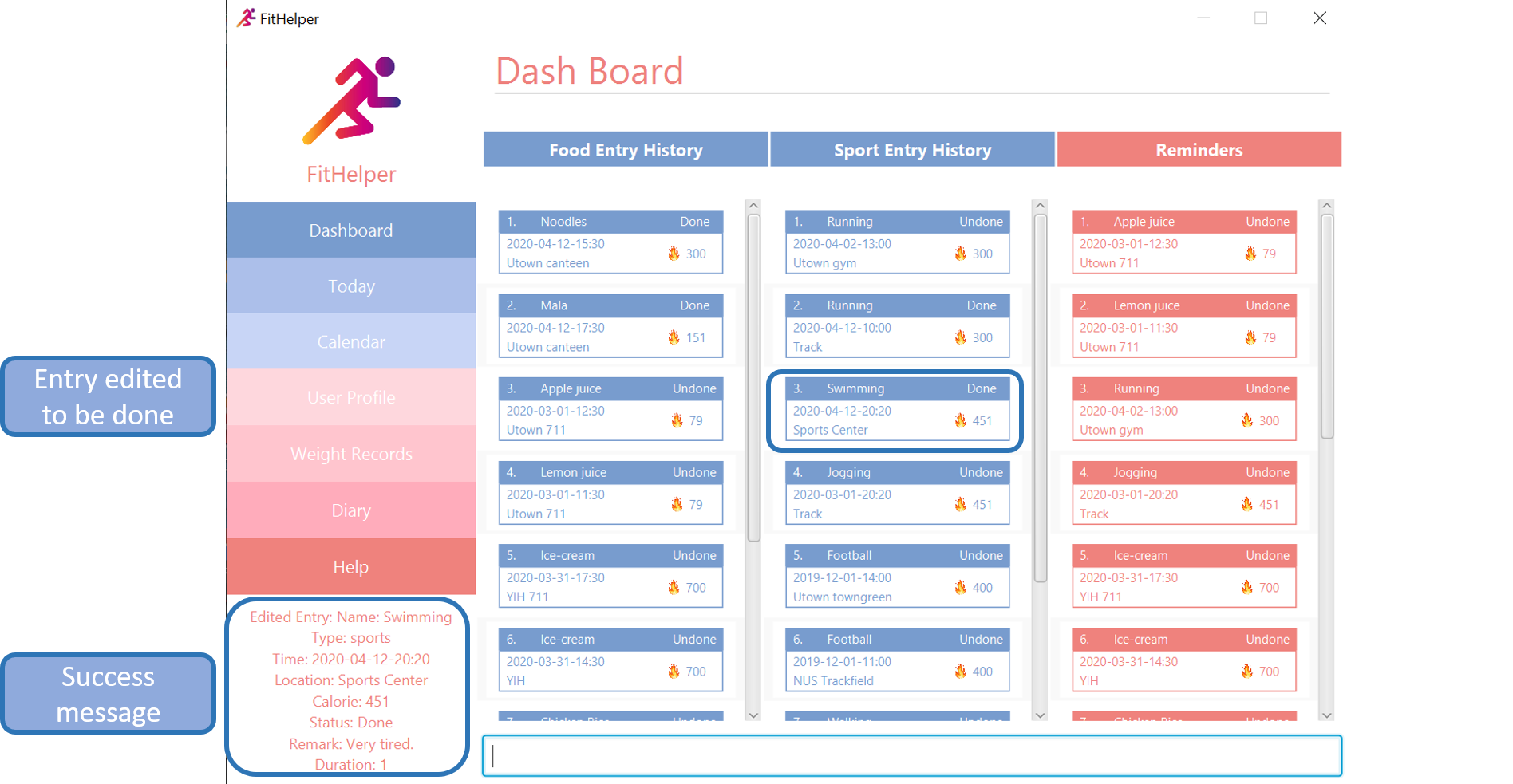
4.2.6. Locating entries by name: find
Finds entries whose names contain any of the given keywords.
Format: find [x/TYPE] k/ONE_OR_MORE_KEYWORDS
If the TYPE field is empty, FitHelper will search from the whole list.
Examples:
-
find x/s k/running
Returnsrunningandslow running -
find x/food k/Juice Apple
Returns any entry having namesJuice, orApple
4.2.7. Deleting an entry : delete
Deletes the entry at the specified INDEX from the fitness log book.
Format: delete x/TYPE i/INDEX
Examples:
-
delete x/sports index/2Deletes the 2nd sports entry in the sports list from dashboard.

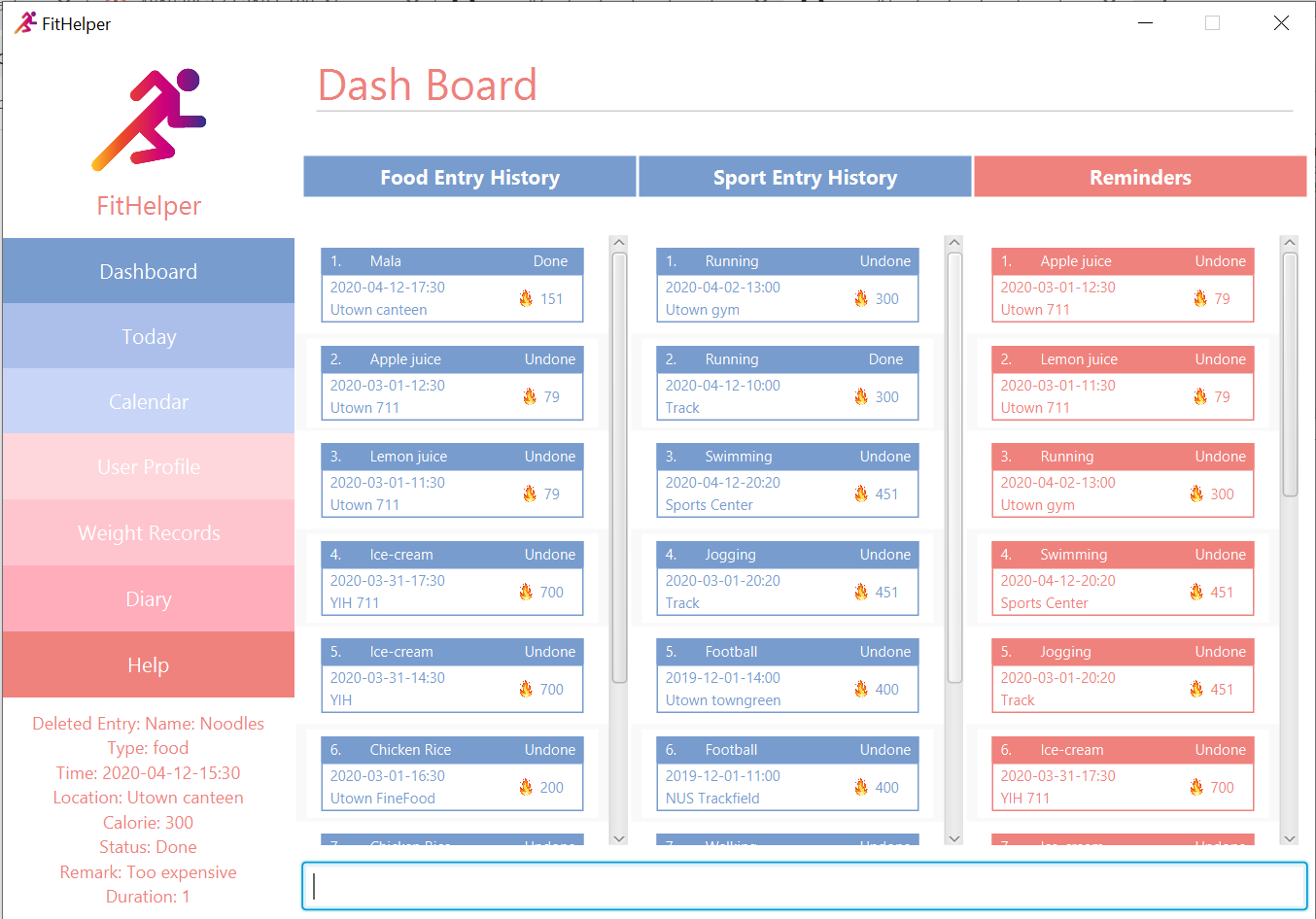
4.2.8. Sort food/sports entry list: sort
Sorts food or sports entry list, or both of them, based on starting time or
calorie value or name of the entry (case insensitive), in either ascending or descending order.
In addition, the reminders entry list will also be sorted in the same manner specified by the user.
The user must specify the sorting criterion cal/c OR time/t OR name/n.
If the user does not specify the type of entry list, both lists will be sorted.
And if the user does not specify the sorting order a OR d,
the default order is descending (i.e. entry that starts later
or entry with higher calorie value or entry whose name starts with
later alphabet comes first).
format: sort [x/TYPE] by/SORT_BY [o/ORDER]
Examples:
-
sort x/f by/time o/a(sort food entry list and reminders list in ascending order of recording time, i.e. the older entry comes first) -
sort by/c(sort both food and sports entry list, as well as reminders list, in descending order of calorie value, i.e. entry with higher calorie intake/consumption comes first)
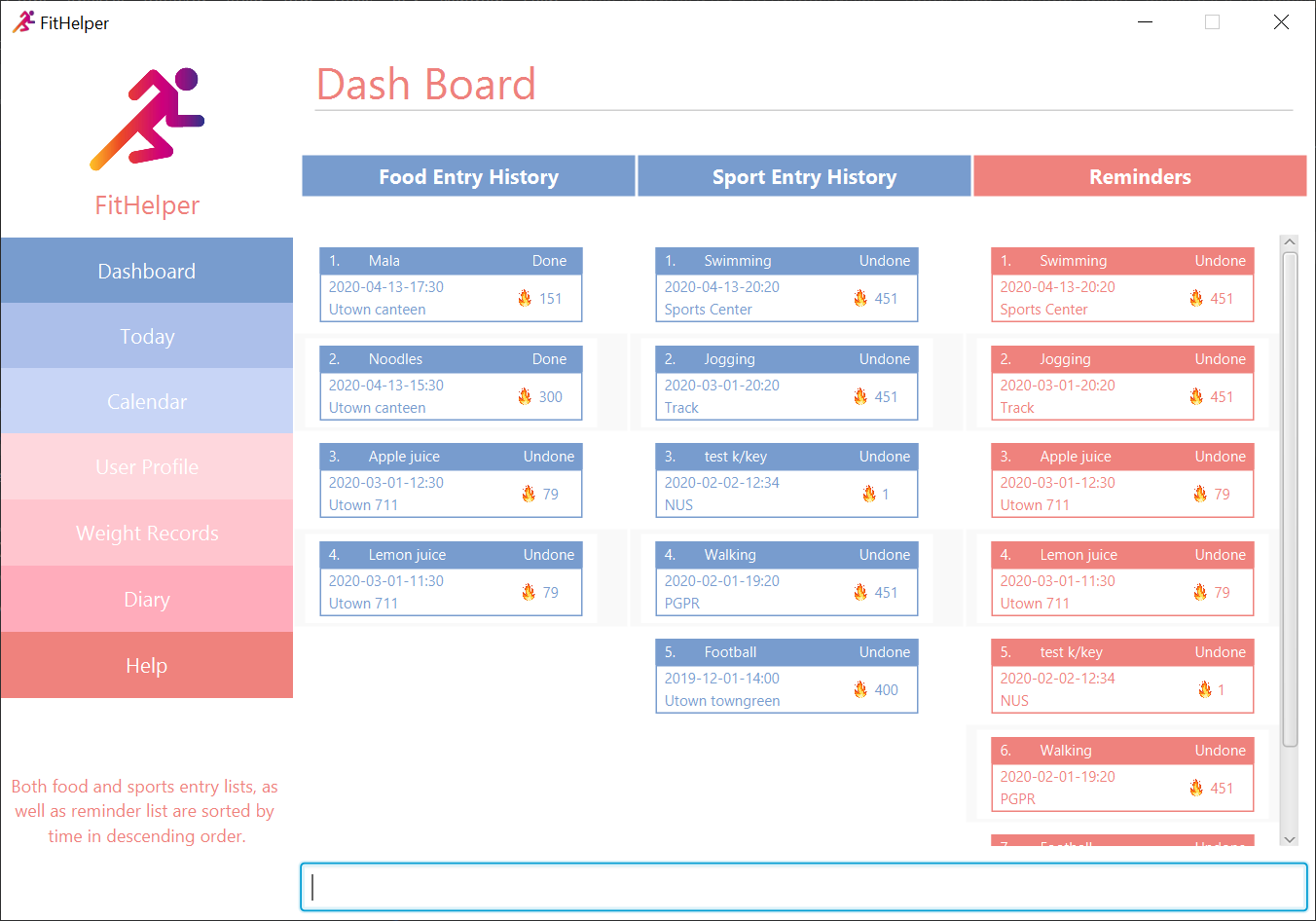
4.2.9. Check calorie intake/consumption of common food/sports: check
Searches through the pre-set database for calorie intake/consumption information about common food/sports (i.e. a datum) whose name matches/contains keywords specified by the user. Note that due to space constraint, at most 3 matching data will be shown at the left-bottom corner of the application. Each datum shows the name of the food/sports and its calorie intake/consumption information: for food, it will be in cal per serving (weight per serving in gram will also be shown); for sports, it will be in cal per hour for a 70kg person. Please note after the command is executed, the application will automatically go to Dashboard page without resetting the display status.
The searching works as follows:
-
Retrieves food/sports data based on check type specified by the user.
-
Checks and adds food/sports datum whose name equals one of the keywords. If fewer than 3 food/sports data are added so far, checks and adds food/sports datum whose name contains the keywords as a whole. If still fewer than 3 food/sports data are added so far, checks and adds food/sports datum whose name contains one of the keywords.
-
If no datum is added after all the steps, replies user that search failed. Otherwise, shows user the data.
format: check x/TYPE k/ONE_OR_MORE_KEYWORDS
Examples:
-
check x/food k/apple(searches for calorie intake of food whose name match/contain keyword "apple")
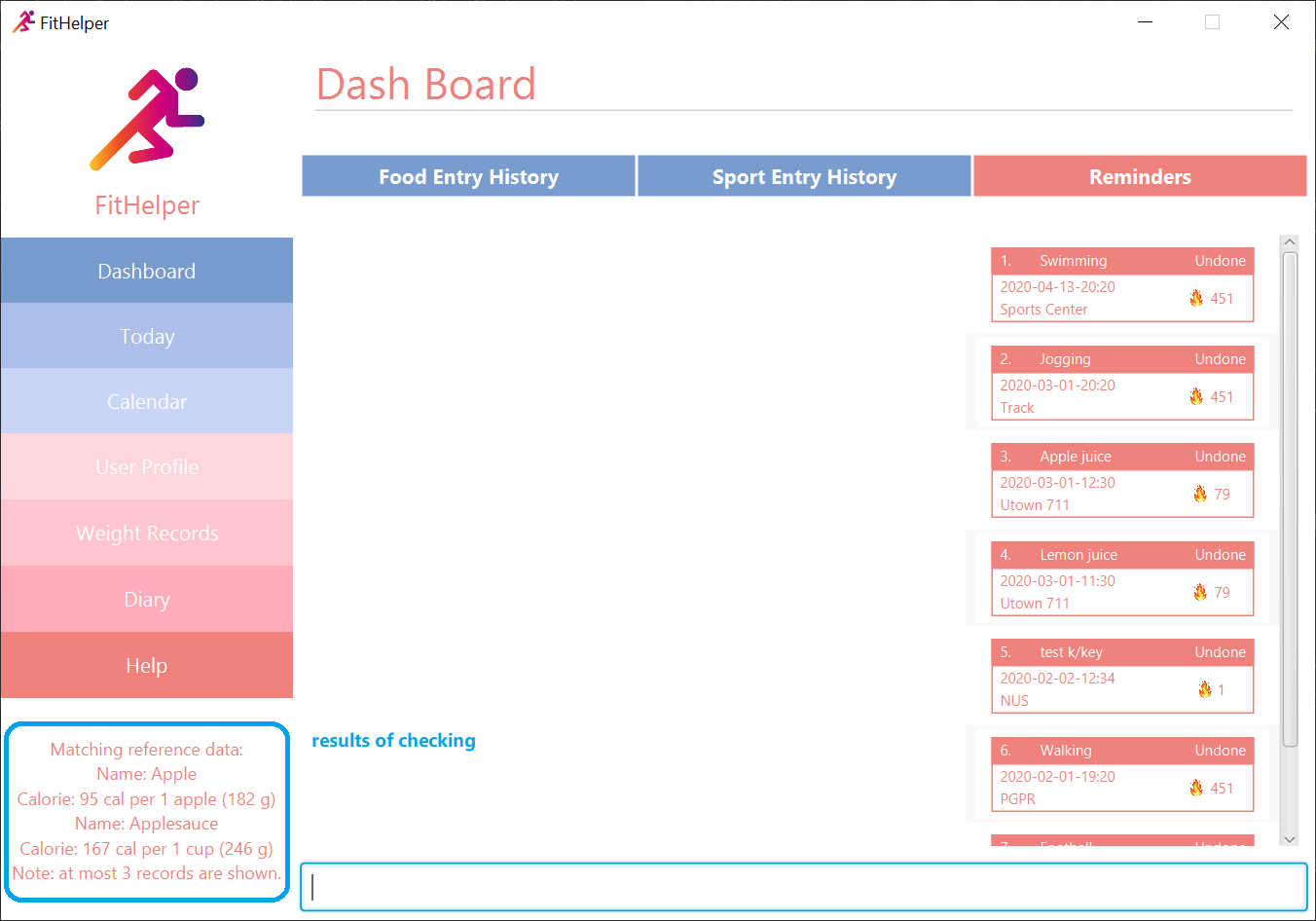
4.3. Keep Diaries
The user can keep a diary in FitHelper, and command for adding/editing/deleting/searching/clearing diary logs.
-
diaryswitches to theDiary Pagewhere all diary logs are displayed in chronological order
4.3.1. Add a new diary: addDiary
-
addDiary d/DATE dc/DIARYCONTENT
adds a new diary on the specifiedDATEwith the specifiedCONTENT
If there is previously added diary on the specified DATE, calling addDiary will rewrite the content.
Examples:
-
addDiary d/2020-03-31 dc/Happy birthday Alice!Adds a diary log on the date2020-03-31with the contentHappy birthday Alice!.
4.3.2. Append new content to an existing diary: appendDiary
-
appendDiary d/DATE dc/APPENDED CONTENT
appends new content to the existing diary on the specifiedDATE.
If the specified DATE does not have previously added diary log, this command will be discarded with a DIARY_NOT_FOUND
reminder.
Examples:
-
appendDiary d/2020-03-31 dc/You are one year older now:)(afteraddDiary d/2020-03-31 dc/Happy birthday Alice!)+ This command appends the new diary content to the existing the diary log on the date2020-03-31. The new diary content after this command will be "Happy birthday Alice! You are one year older now:)".
4.3.3. Edit a diary: editDiary
-
editDiary d/DATE dc/NEW DIARYCONTENT
edits the diary on the specifiedDATEwith the newDIARYCONTENT.
If the specified DATE does not have previously added diary log, this command will be discarded with a DIARY_NOT_FOUND
reminder.
If the existing diary with the specified DATE has the same content as the specified content, this command will be discarded with a DUPLICATE_DIARY
reminder.
Examples:
-
editDiary d/2020-03-31 dc/Happy birthday Alice!
This command edits the content of the diary log on the date2020-03-31with the contentHappy birthday Alice!.
4.3.4. Find a diary: findDiary
-
findDiary [d/DATE] [k/ONE OR MORE KEYWORDS]
finds diaries either on the specifiedDATEor contains the specifiedKEYWORDS.
BothDATEandKEYWORDSfields are optional. If neither appear, FitHelper will display all diaries.
If there is no diary under the specifiedDATE, this command will be discarded with the reminder ofDIARY_NOT_FOUND.
Examples:
-
findDiary k/running
Displays diaries with their content containing the keywordrunning, ignoring the letter capitalization. -
find d/2020-03-31 k/cake
Returns the diary on the date of2020-03-31regardless of theKEYWORDSfield.
4.3.5. Delete a diary: deleteDiary
-
deleteDiary d/DATE
deletes the diary on the specifiedDATE.
If there is no diary under the specified DATE, this command will be discarded with the reminder of
DIARY_NOT_FOUND.
Examples:
-
deleteDiary d/2020-03-31
This command deletes the diary log on the date2020-03-3, if the diary on this date exists, and discards the command if no diary was added previously on this date.
4.3.6. Clear the diary: clearDairy
-
clearDiary+ clears all diary logs in this FitHelper.The user can always revoke the clearing command by calling undo, which will be explained in a later section.
4.4. Clear All Entries And Diaries: clear
Clears all entries and diaries from the fitness log book.
Format: clear
4.5. Undo : undo
undo revokes the last undoable command.
This command back-roll FitHelper to the previous status before the last undoable command was executed.
Undoable commands include: add, edit, delete, clear, addDiary, appendDiary, editDiary, deleteDiary, clearDiary.
Other commands are not affected by undo command. The same applies for redo.
|
After executing undo or redo, FitHelper switches to Home Page (DashBoard).
|
Examples:
-
undo(afteraddDiary d/2020-03-31 dc/I am happy.)
Thisundocommands remove the added diary log from FitHelper.
4.6. Redo : redo
redo is the reverse of undo.
This command re-execute the last undoable command that has been undone.
redo can only be executed after an undo has been previously performed.
|
Examples:
-
redo(afterundo-ing the previousaddDiary d/2020-03-31 dc/I am happy.)
Thisundocommands adds the diary log back to FitHelper.
4.7. Calendar View
Calendar view will display all the food and sports entries for each day of the referenced week/month. The referenced date is default set to be the current date, but can be changed to a user given date. Calendar can be switched between two modes, list mode or timetable mode, with default set to be in timetable mode.
Format for entering calendar view: calendar
4.7.1. Calendar list mode: calendar m/ls [d/DATE]
-
Monthly View
The lists of entries for food and sports are display by their given dates in the referenced month. Completed entries will be strikethrough. Calorie value is also shown for each date. -
Calendar of the month
On the top right corner, the dates of the referenced month displayed, with red-colored date if the given date has more calorie intake than calorie burnt (considering the entries with status done of that particular date), else if calorie burnt is greater than calorie intake, the font color is green. Default color is blue. For each date, upon clicking, a popup window will show all entries of the date. The ones with strikethrough in text means the status of the entry is done. For this functionality, the corresponding command iscalendar sh/DATE. -
Daily calorie status
On the bottom right corner, calorie status for existing entries will be displayed by their dates, showing the calorie intake from food, calorie burnt from sports as well as total calorie. The calculation only considers entries which are completed.
Format for switching to list mode: calendar m/ls [d/DATE]
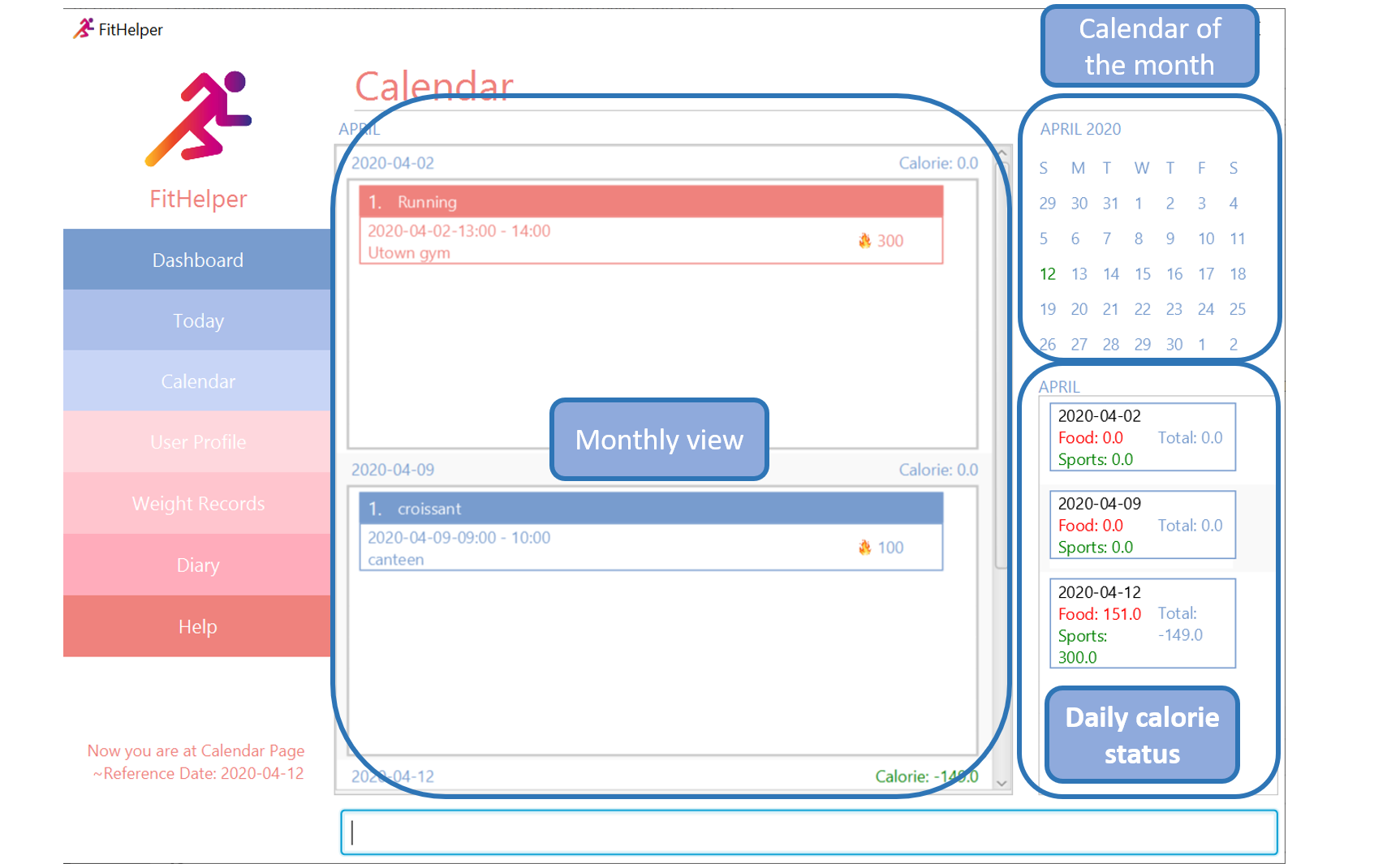
4.7.2. Calendar timetable mode: calendar m/tb [d/DATE]
-
Weekly View
The entries of food and sports of the given time period are displayed. Food entries will be in pink, sports entries will be in blue, and entries completed will be in grey regardless of their type. No entries can have time clashes. Entries with long names or locations will not be displayed fully. Only when mouse is over the entry, the details will be shown. Entries upon clicking will have console errors, caused by disabling certain functionality from third party libraries. -
Calendar of the month
Same as above. -
Upcoming list
It displays all entries of which start time is after the current date and time and within the referenced month. Only entries with statusUndonewill be shown. So if the referenced month is in the past, no entries will be shown.
Format for switching to timetable mode:calendar m/tb [d/DATE]
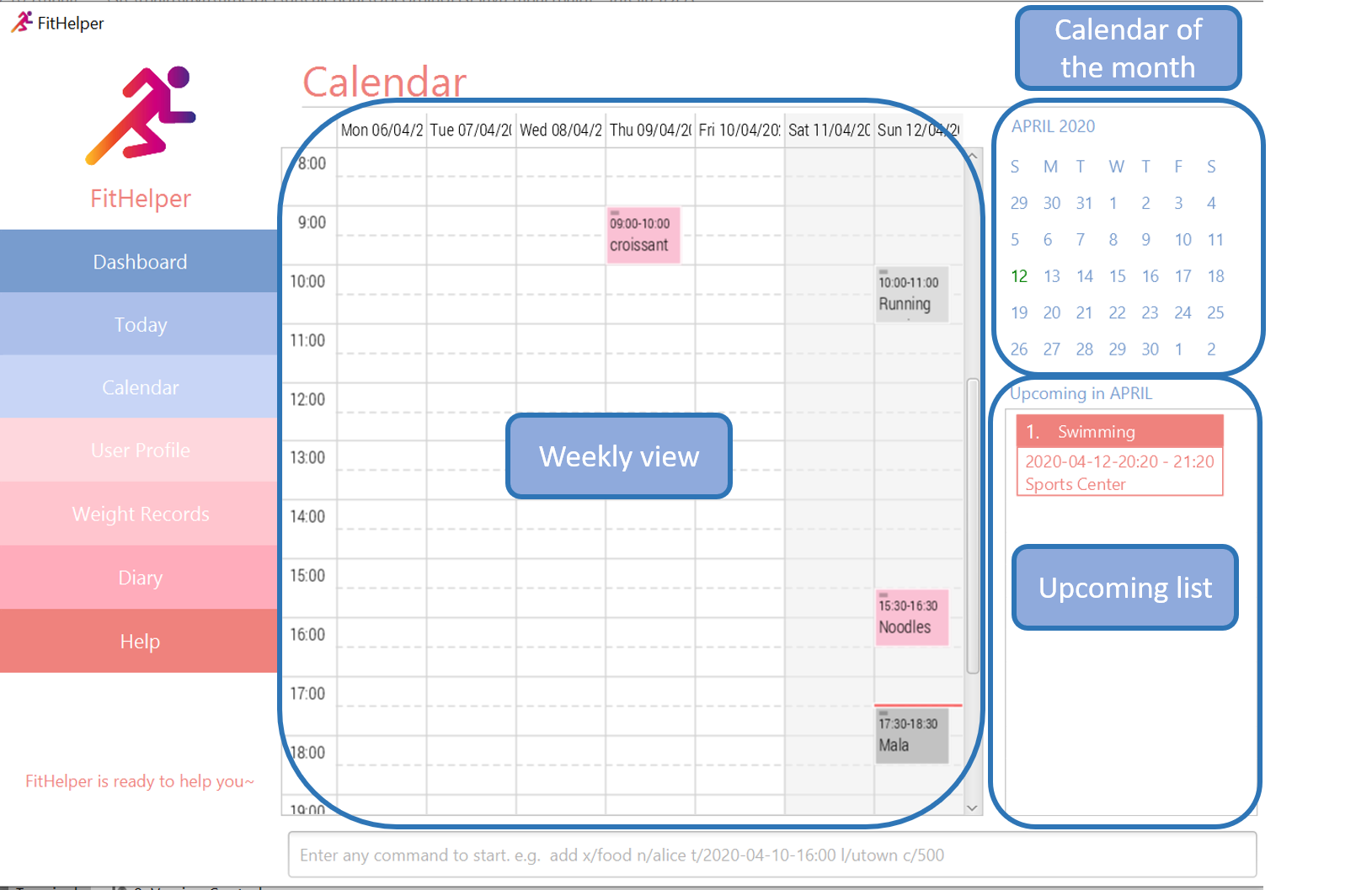
4.7.3. Calendar display entries from a day: calendar sh/DATE
A pop up window will display all entries from the chosen date.
Format for showing entries of a particular date: calendar sh/DATE
4.7.4. Set calendar referenced date: calendar d/DATE
Sets the referenced date of the current calendar page.
Format for showing entries of a particular date: calendar d/DATE
Examples:
-
calendar m/tb d/2020-04-15 -
calendar m/ls d/2020-04-20 -
calendar sh/2020-05-01
4.8. Daily Summary
4.8.1. Today Page: today
Today page serves to be a summary for the daily arrangements.
It shows the daily schedule for the user. Users can see the entries for the day, a recommended lunch place, and their performances. They can also see their diary for the day as well as the rewarding point.
Format: today
-
Daily Food/Sports Entries
The lists of food and sports entries on "today" are displayed in two list view, with indices in chronological order specific for today. -
Plan Counter
The 4 counters keep track of the number of done/undone food/sports plans on today. -
Calorie Report
Calorie report contains the data of daily calorie intake/consumption from done food/sports entries correspondingly. The food calorie pie chart consists of all food entries on today, regardless of the status. The labels are the corresponding indices of the food entries inToday’s Foodlist. From the pie chart, the user can view the component of calorie intake of each food entry, so he/she can adjust the diet plan.In cases where some food entries contribute to the great majority of the total food intake, the pie chart only displays labels for food entries that contain relatively high calorie values. -
Task Completion
The user’s daily task completion is shown in percentage (round to integer). -
FitHelper Feedback
Based on the user’s intake food calorie and sport task completion, FitHelper provides suggestions and reminders in theFitHelper Feedbackarea.
4.8.2. Some Day Page [coming in v2.0]
The Today Page for some day in the history can be displayed.
Format: today DATE
The DATE should be equal or prior to today. Requiring a Today Page for a future date will generate a blank page if that particular day does not have any entries.
|
Examples:
-
today 2020-02-14
4.9. Weekly Summary
4.9.1. Weekly Report [coming in v2.0]
A weekly report serves as a summary for the past week. The user can see his performance in the past week. The weekly report also contains his rewarding points, diary logs, and preferred sports and food from the previous week.
Format: weekreport
-
Weekly Performance
The weekly performance is generated based on the ratio of done and undone tasks and the calorie consumption, together with the system feedbacks. -
Rewarding Points
Rewarding points gained from the past week and current "fit level" is also shown. The weekly increment of rewarding points from past several weeks can be visualized. -
Trendy Food and Sports
Users can see his preferred food and sports, based on his entries for the past week.
4.9.2. Some Week Report [coming in v2.0]
The Week Report for some week in the history can be displayed.
Format: weekreport DATE where DATE specifies the week it is in
The DATE should be equal or prior to days in the current week. Requiring a Week Report for a future week will generate a blank page if that particular day does not have any entries.
|
Examples:
-
weekreport -
weekreport 2020-02-14
4.10. Keep User Profile
4.10.1. Profile Page: profile
Profile page serves to be a summary for basic user data.
The profile information includes: Name, Age, Gender, Address, Height, Target Weight, Current Weight and Current BMI.
Format: profile
4.10.2. Update Profile Data : update
Update user data in the profile by attributes. Profile attributes include: Name, Age, Address, Gender, Height and Target Weight.
Every update command will lead to the profile page.
Format: update [-f] attr/ATTRIBUTE v/VALUE
Examples:
-
update attr/height v/160 -
update -f attr/name v/Alice Wang
4.11. Keep Weight Records
4.11.1. Weight Page: weight
Weight page serves to be a summary for user’s weight and BMI changes according to time.
It shows user data in graph for easy understanding. By default, it will generate graph from all history data chronologically.
-
Gap notification
The top notification shows the comparison between user current weight and target weight.-
If current weight is larger than target, the gap between the two will be highlighted.
-
If current weight is the same or less than the target, a succeed notification will be generated.
-
-
Trend Graph - Weight
Display a trend graph of user’s weight according to time. -
Trend Graph - BMI
Display a trend graph of user’s BMI according to time. The BMI value is calculated by weight and height value at that date.
Format: weight
4.11.2. Add Weight Records : addWeight
Add a new weight record into the weight records database. A weight record is related to date and weight value, and a auto-computed BMI value will be stored as well.
Every addWeight command will lead to the weight page.
If a new weight record is added successfully, two new points will be added into the two trend graphs separately.
Format: addWeight v/WEIGHT_VALUE [d/DATE]
Examples:
-
addWeight v/50.0 d/2020-02-01 -
addWeight v/52.30
4.11.3. Edit Weight Records : editWeight
Edit an existing weight record in the weight records database.
A weight record is identified by its unique date, and user can find the date on the x-axis of the Weight Trend Graph.
User are able to edit the weight value, and corresponding BMI value will be auto-computed using the new weight value and user’s current height.
Every editWeight command will lead to the weight page.
If a weight record is edited successfully, two new points will change their positions on the two trend graphs separately.
Format: editWeight [d/DATE] v/NEW_WEIGHT_VALUE
Examples:
-
editWeight d/2020-02-01 v/51.0 -
editWeight v/52.40
4.11.4. Delete Weight Records : deleteWeight
Delete an existing weight record in the weight records database.
Same as editWeight command, a weight record is identified by its unique date, and user can find the date on the x-axis of the Weight Trend Graph.
Every deleteWeight command will lead to the weight page.
If a weight record is deleted successfully, two corresponding points will be removed from the two trend graphs separately.
Format: deleteWeight [d/DATE]
Examples:
-
deleteWeight d/2020-02-01 -
deleteWeight
4.11.5. Clear Weight Records : clearWeight
Clear all weight records in the weight records database.
Weight Page’s graphs will be empty, and
Profile Page’s Current Weight and Current BMI fields will be Not Available Now after clear all weight records.
Format: clearWeight
4.13. Save the data
fitness log book data are saved in the hard disk automatically after any command that changes the data.
There is no need to save manually.
5. Command Summary
-
Help - switch to Help Page :
help
-
Entry - switch to DashBoard :
home -
Entry - add an entry
add x/TYPE n/NAME t/TIME l/LOCATION c/CALORIE … -
Entry - list all entries or entries of a given date :
list [d/DATE] -
Entry - view reminders list only :
reminder -
Entry - edit an entry :
edit x/TYPE i/INDEX [n/NAME] [t/TIME] [l/LOCATION] [c/CALORIE] … -
Entry - find and list entries by keywords :
find k/KEYWORDS -
Entry - delete an entry :
delete x/TYPE i/INDEX -
Entry - sort entry list :
sort [x/TYPE] by/SORT_BY [o/ORDER] -
Entry - check calorie reference :
check x/TYPE k/KEYWORDS
-
Diary - switch to Diary Page :
diary -
Diary - add a diary :
addDiary d/DATE dc/CONTENT -
Diary - edit a diary :
editDiary d/DATE dc/CONTENT -
Diary - delete a diary :
deleteDiary d/DATE -
Diary - find a diary :
findDiary [d/DATE] [k/KEYWORDS] -
Diary - clear all diaries :
clearDiary
-
Clear - clear all entries and diaries :
clear -
Undo - undo commands related to entries and diaries :
undo -
Redo - redo commands related to entries and diaries :
redo
-
Calendar - switch to Calendar Page :
calendar -
Calendar - display from a referenced date :
calendar d/DATE -
Calendar - change to list mode :
calendar m/ls [d/DATE] -
Calendar - change to timetable mode :
calendnar m/tb [d/DATE] -
Calendar - display entries from a particular date :
calendar sh/DATE
-
Today - switch to Today Page :
today
-
Profile - switch to Profile Page:
profile -
Profile - update profile data:
update [-f] attr/ATTRIBUTE V/VALUE
-
Weight - switch to Weight Page:
weight -
Weight - add a weight record
addWeight v/VALUE [d/DATE] -
Weight - edit a weight record
editWeight [d/DATE] v/VALUE -
Weight - delete a weight record
deleteWeight [d/DATE] -
Weight - clear all weight records
clearWeight
-
Exit the Program:
exitorbyeorquit